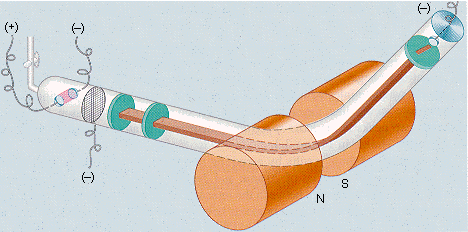
A block diagram of a mass spectrometer.
F. W. Aston
Mass Spectrometer (F. W. Aston)
The mass spectrometer was invented by F. W. Aston shortly after World War I. By 1927 Aston had built an instrument that was accurate to more than 1 part in 10,000, and mass spectrometry became the method of choice for measuring the relative mass of an atom or molecule. It can tell us, for example, that the mass of a single fluorine atom is 2.010808 times the mass of a beryllium atom.
The logical units for reporting the relative mass of an atom are atomic mass units, or amu. The lightest atom is assigned a mass of 1 amu and the mass of any other atom is expressed in terms of this standard.
|
A block diagram of a mass spectrometer. |
The Difference between Atomic Mass and Atomic Weight (F. W. Aston)
Shortly after he began his work with the mass spectrometer, Aston obtained surprising results when he injected a sample of neon into his instrument. According to the best estimates at the time, the atomic weight of neon was 20.2 amu. Aston, however, observed two peaks in the mass spectrum of neon with relative masses of 20.0 and 22.0 amu.
Aston explained these results by assuming that there are two different kinds of neon atoms, one with a mass of 20 amu and the other with a mass of 22 amu. He then explained the difference between the intensity of the two peaks in the spectrum by suggesting that 90% of the neon atoms have a mass of 20 amu and 10% have a mass of 22 amu. Neon therefore has an atomic weight of 20.2 amu because it is a weighted average of 90% of the lighter atom and 10% of the heavier atom.
Aston called these different neon atoms isotopes (literally, "same place") using a term introduced by Frederick Soddy in 1911 to describe different atoms that occupy the same place in the periodic table.
| History of Chemistry |
| Experiments Index |
| Scientists Index |